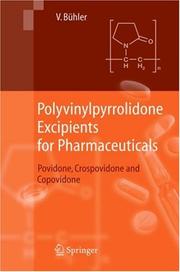| Listing 1 - 2 of 2 |
Sort by
|

ISBN: 3540270906 3540234128 3642062431 Year: 2005 Publisher: Berlin ; New York : Springer,
Abstract | Keywords | Export | Availability | Bookmark
 Loading...
Loading...Choose an application
- Reference Manager
- EndNote
- RefWorks (Direct export to RefWorks)
The book describes the properties, analytical methods and the applications of different polyvinylpyrrolidone excipients (povidone, crospovidone, copovidone etc.) for use in pharmaceutical preparations. This group of excipients is one of the most important excipients used in modern technology to produce drugs. The book is intended for all persons working in the research, development and quality control of drugs. It gives a survey of all applications in solid, liquid and semisolid dosage forms including many drug formulation examples and more than 600 references to the literature.
Povidone. --- Excipients. --- Drug emulsifying agents --- Drug formulation agents --- Drug stabilizing agents --- Drug suspending agents --- Emulsifying agents for drugs --- Suspending agents for drugs --- Drugs --- Stabilizing agents --- Ethenylpyrrolidinonehomopolymer --- Polyvidon --- Polyvinylpyrrolidone --- PVP --- Blood plasma substitutes --- Pyrrolidine --- Pharmacy. --- Polymers. --- Analytical biochemistry. --- Polymer Sciences. --- Analytical Chemistry. --- Analytic biochemistry --- Biochemistry --- Chemistry, Analytic --- Polymere --- Polymeride --- Polymers and polymerization --- Macromolecules --- Chemistry --- Medicine --- Materia medica --- Pharmacology --- Bioanalytic chemistry --- Bioanalytical chemistry --- Analytical chemistry --- Polymers . --- Analytical chemistry. --- Analysis, Chemical --- Analytic chemistry --- Chemical analysis
Book
Year: 2020 Publisher: Basel, Switzerland MDPI - Multidisciplinary Digital Publishing Institute
Abstract | Keywords | Export | Availability | Bookmark
 Loading...
Loading...Choose an application
- Reference Manager
- EndNote
- RefWorks (Direct export to RefWorks)
This book is a collection of papers published in the Special Issue of Pharmaceutics, entitled "Pharmaceutical Particulates and Membranes for Delivery of Drugs and Bioactive Molecules". A drug release profile is a consequential factor for nanoparticle application, directly related to drug stability and therapeutic results, as well as formulation development. Pharmaceutical particulates of different sizes and shapes (e.g., liposomes, oil-in-water emulsions, polymeric nano- and microspheres, metallic nanoparticles (NPs) such as gold, silver and iron oxide crystals, and core-shell hybrid NPs) offer many diagnostic and therapeutic applications. Membranes are also extensively utilized in many applications. They are especially beneficial to the distribution of macromolecular drugs and biopharmaceutical drugs (peptides, proteins, antibodies, oligonucleotides, plasmids, and viruses) with physicochemical and pharmacokinetic vulnerability. The delivery of drugs and bioactive molecules using particulates and membranes has gained a great deal of attention for various applications, such as the treatment of secondary infections, cancer treatment, skin regeneration, orthopaedic applications, and antimicrobial drug delivery. In addition, several production techniques have been utilized for the fabrication of particulates and membranes in the last decade, which include lyophilisation, micro-emulsion, nano-spray dryer, nano-electrospinning, slip casting and 3D printers. Therefore, pharmaceutical particulates and membranes possess excellent prospects to deliver drugs and bioactive molecules with the potential to improve new delivery strategies like sustained and controlled release.
alginate gelispheres --- textural analysis --- crosslinked matrices --- PLGA discs --- prolonged release --- powder flow properties --- microfluidics --- coculture --- HER2 --- polystyrene µPs --- biofunctionalization --- coaxial electrospraying --- polymeric nanoparticles --- spreading angle --- process-property-performance relationship --- nanoemulsion --- mixture design --- aqueous humor --- antimicrobial activity --- sustained release pellets --- double coating layer --- loxoprofen --- citric acid --- pharmacokinetic studies --- biomimetic magnetite --- drug delivery --- magnetic hyperthermia --- magnetite --- MamC --- nanoparticles stability --- pharmaceutical particulates --- membranes --- drug delivery systems --- bio-imaging --- bioactive molecules --- composite --- N-hydroxyphthalimide --- carbon dots --- polymer gels --- antitumoral activity --- wound dressing --- polymeric membrane --- nanoparticles --- curcumin --- alginate --- pluronic F68 --- drug skin permeation --- Franz cells --- tape stripping --- wound infection --- biofilm --- pseudomonas aeruginosa --- antimicrobial delivery --- polyvinylpyrrolidone --- nanofibers --- red blood cells membrane --- arsenic trioxide --- sodium alginate nanoparticles --- reduce toxicity --- anti-tumor --- pediatric drug delivery --- tuberculosis --- reconstitutable dry suspension --- isoniazid --- polymer-lipid --- microparticulate --- direct emulsification --- n/a
| Listing 1 - 2 of 2 |
Sort by
|

 Search
Search Feedback
Feedback About UniCat
About UniCat  Help
Help News
News